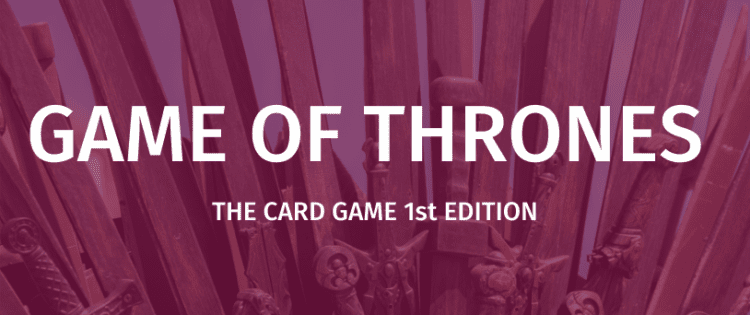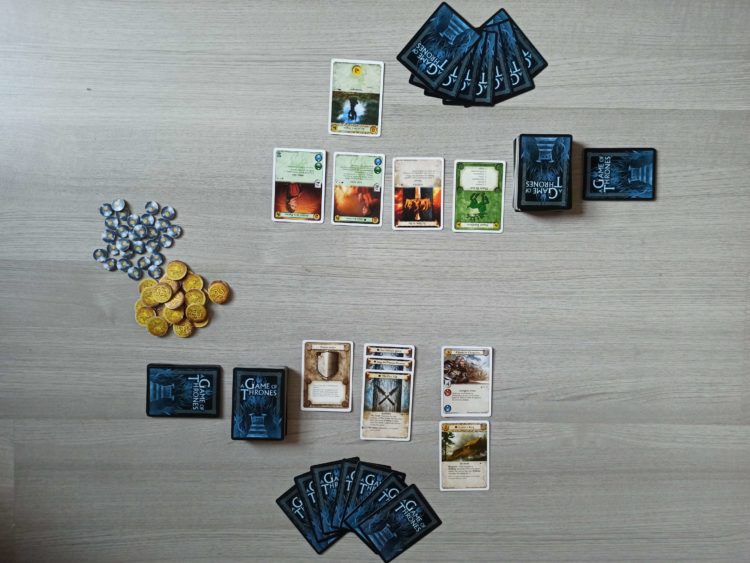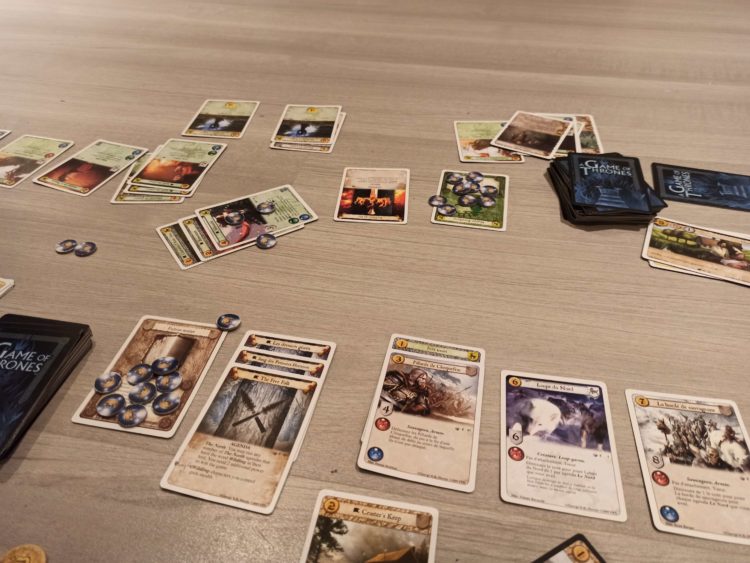
OBJECTIVE OF GAME OF THRONES THE CARD GAME 1st EDITION: The objective of Game of Thrones The Card Game 1st Edition is to win 15 power points before your opponent does.
NUMBER OF PLAYERS: 2 to 4
MATERIALS:
Core set materials:
- 220 cards (55 cards per House, for Stark, Lannister, Baratheon and Targaryen houses)
- 60 Power tokens
- 44 Gold tokens
- 1 game board (to play with more than 2 players)
- 6 Title figurines (to play with more than 2 players)
TYPE OF GAME: strategic expert card game
AUDIENCE: teen, adult
OVERVIEW OF GAME OF THRONES THE CARD GAME 1st EDITION
In Game of Thrones: The Card Game, join the houses of Stark, Lannister, Targaryen, Baratheon, Greyjoy, Martell as they seek to seize the Iron Throne.
Game of Thrones: The Card Game is a game of intrigue, politics, betrayals and battles based on the novels of George R.R. Martin.
Each player embodies one of the factions that seek to influence and control the Iron Throne in order to seize power in Westeros. Each player has two decks of cards: a deck of draw cards, which feeds the forces at his disposal, and a deck of plots, which is used to develop a long-term strategy.
As the game progresses, players engage in military battles, court plots and power struggles until one of them is victorious.
SETUP
Each player chooses a faction, which can be one of the 6 main houses or a neutral faction, and a deck from that house. A deck consists of:
- a House card, displaying the symbol of the chosen house
- an Agenda card (optional), which modifies certain rules in a global way
- a deck of at least 60 cards
- a deck of plots, of exactly 7 cards
Each player places his two decks in front of him, along with his house card, and then draws 7 cards from his draw deck. From these 7 cards he chooses a combination of Character and/or Location cards whose total cost does not exceed 5, which will constitute his starting strength. He places them in front of him, face down. When each opponent has done the same, the players reveal their set-up cards, then complete their hand until they have 7 cards again.
Note: Some Attachment cards have the keyword “Set-up” which indicates that they can be played during Set-up, provided they are attached to an eligible card.

GAMEPLAY
Types of cards
House cards indicate the house controlled by each player. There is also a Neutral House card, which does not actually correspond to any house.
Agenda cards are strategic cards that profoundly change the way a deck works. A player can usually have one and only one Agenda card, placed next to his House card.
Plot cards are strategy cards that allow the player to momentarily influence the course of the game for the duration of a turn. A player must have exactly 7 Plot cards. Each Plot card has:
- 3 icons representing, from left to right, the player’s income, initiative and claim (i.e. the damage he inflicts during challenges)
- a text describing the plot’s effect, which may be permanent, triggered immediately (in which case it will be marked “when revealed”) or triggered subject to conditions (indicated in the text of the effect)
The Character, Location, Attachment and Event cards make up the player’s draw deck.
Characters, Locations and Attachments are permanent cards and have a recruitment cost in the top left corner, which must be paid in gold during the Marshalling phase of their owner. Conversely, Event cards are immediate-effect cards that can be played directly, including during other players’ turns, under certain conditions specified on the card.
The Characters:
- have a Strength value (shield icon), used during challenges and hegemony
- may have icons corresponding to the three types of confrontation that can take place: military, power and intrigue
- may have virtue icons (bottom right) used by some card effects: Warrior (crossed swords), Noble (ring), Scholar (open book) and Mystic (chalice).
Attachments are cards representing objects, conditions or other situations that apply to a Person or Location. An Attachment is placed under the Character or Location to which it is attached.
Other icons in the text box of the permanent cards:
- Gold: the value indicated represents an income bonus at the beginning of the Marshalling phase.
- Initiative: the value indicated in the diamond represents a bonus applied when determining the initiative in the Plot phase.
- Influence: the value shown in the rectangle indicates the number of influence points provided by this map.
Course of the game round
A game round is divided into 7 successive phases
- Plot phase
- Draw phase
- Marshalling phase
- Challenges phase
- Dominance phase
- Standing phase
- Taxation phase
1. Plot phase
Each player consults his pile of plots freely and secretly chooses a plot to activate during the turn. When all players have chosen, the plots are revealed simultaneously:
- the plot revealed by each player is placed on top of his pile of used plots
- the player with the best initiative (that of his plot + plus that of his other cards in play) chooses who will be the first player in the round
- any “when revealed” effects that may be present on the plots revealed are applied, starting with designated first player and going clockwise
2. Draw phase
Each player draws two cards from his or her deck.
3. Marshalling phase
Starting with the player designated as the first player during the plot phase, then clockwise, each player will:
- take his income: receive from the bank as many gold coins as indicated on his plot and other cards in play
- play as many cards from his hand as he wishes by paying their cost in gold
Remarks:
- Cards that bring in gold will only add gold to a player’s income on the turn following the turn they are played.
- Gold penalty: if you have a House card that is not the neutral faction, you have to pay 2 extra gold to play a card from another House
4. Challenges phase
During this crucial phase of the turn, players will, always in turn order, challenge other players in one or more of the three areas of confrontation: military (red axe icon), power (blue crown icon) or intrigue (green eye icon).
How a challenge is done:
- the active player (called the attacker) declares the type of challenge (military, power or intrigue) and the targeted player (called the defender)
- the attacker declares one or more attacking characters (which must have the icon of the type of challenge declared) and kneels them
- for each participating character having the keyword Stealth, the attacker designates a defender character who does not have the keyword Stealth, to prevent that character from being declared defender
- the defending player declares (or not) defending characters (which must have the icon of the type of challenge declared) and kneels them
- resolution: the combined strength of the attacking characters is compared with that of the defending characters, and if the attacker has greater or equal strength, he wins the challenge.
- application of losses: if the attacker has won the challenge, he inflicts a number of losses equal to the claim value of his plot card, the nature of which depends on the type of challenge
- military challenge: the defender chooses as many characters under his control, participants in the challenge or not, and places them in his pile of the dead
- challenge power: the attacker moves as many Power tokens from the defender’s House card to his House card (if there are not enough, he completes by taking from the reserve)
- challenge intrigue: the attacker randomly draws as many cards from the defender’s hand and places them in the opponent’s discard pile.
- in addition, and regardless of the type of challenge, if the defender’s strength was 0, the challenge is considered unopposed, and in this case the attacker takes an extra Power token from the reserve and places it on his House card
- whoever wins the challenge, his participating characters with the keyword Renown each take a Power token (on themselves)
- Regardless of which player wins the challenge, and regardless of the type of challenge declared, if the attacking player has more participating characters with the keyword Killer than the defender, the defender must choose and kill one of his remaining defending characters.
The active player can declare one and only one challenge of each type, hence three challenges total, before passing the hand to the next player clockwise.
Other rules for challenges:
- if the defender wins the challenge, he does not apply his plot’s claim
- a character who has been kneeled (e.g. to participate in a previous challenge) cannot be kneeled again to participate as an attacker or defender in a challenge
- the characters with the keyword Vigilant (Baratheon house) stand up when they have won a challenge in attack
- characters with the keyword Vindictive (Martell house) stand up when they have lost a challenge in defence
- when a character with the keyword Intimidate (Greyjoy House) participates as an attacker in a challenge, characters with a lower strength than him cannot be declared defenders
5. Dominance phase
During this phase, each player adds up his gold left over with the strength of his standing characters. The player with the highest score wins the dominance and places one Power token from the reserve on his House card.
6. Standing phase
Players simultaneously stand all their kneeled cards.
7. Tax phase
Players who still have gold place it back in the bank.

OTHER POINTS OF RULES
Influence
When an effect requires a certain number of influence points to be kneeled, the player must kneel the necessary card(s) when using the influence. Any excess influence is lost, and the kneeled card(s) can no longer be used for other effects that require kneeling (such as participating in a challenge).
Unique and duplicate cards
Unique cards represent a famous place, attachment or person, and have a flag icon next to their title. When a unique card is in play, no player may play a card with the same name. The only exception is the player controlling the card, who may play a card with the same name as a duplicate. This duplicate card becomes attached to the card already in play, and may be discarded to save the card already in play from an effect that would have killed it, discarded it from play, or returned it to the owner’s hand.
There are several variants of cards with the same name. Only the values and texts of the card already in play count, all other cards with the same name played later lose all their characteristics when they become a duplicate of the card already in play.
Other keywords
- Immunity: some cards are immune to certain effects, and therefore cannot undergo them or be targeted by them.
- Limited: it is forbidden to play more than one card with the keyword Limited per turn.
- No attachments: some cards cannot receive attachments (sometimes with exceptions), except for duplicates which are not actual attachments.
- Ambush (Targaryen house): a card with this keyword can be put in play as if it were an ‘Any Phase’ effect by paying influence instead of gold.
- Infamy (Lannister house): when you take power for your House card, you can distribute all or part of this power on your cards with the keyword Infamy
- Stalwart (Stark house): when a card with the Stalwart keyword is killed or discarded from the deck, it is instead put back on top of its owner’s draw pile.
END OF GAME
At any time during the game, if a player totals 15 or more Power points on his playing cards and House card, he wins the game immediately.

Enjoy! 😊
VARIATIONS
Rules for 3 or 4 players
The above rules are the rules of the game in jousting mode, one on one. The Melee mode, with 3 or 4 players, uses the same rules with the following additions.
Installation
- Place the game board in the centre of the table.
- Place the Power and Gold tokens in the spaces provided
- Place the 6 Title figures in the spaces provided.
Plot Phase
After choosing and revealing the plots, and determining the first player, the latter chooses a title and takes the corresponding miniature. Then each player does the same clockwise.
The game board shows the opposition and support between the titles:
- a dark triangle pointing from one title to another indicates that this title is opposed to the pointed title
- a clear arrow pointing from one title to another indicates that this title supports the pointed title
Support
- it is forbidden to declare a challenge against a player bearing a title that you support
- if a player with a title that you support is attacked and does not declare defenders, you can declare defenders in his place, with your standing characters; if you lose the challenge, the defending player still suffers the losses determined by the type of challenge and claim of the attacker’s plot
Opposition
When you win a challenge against a player with a title you are opposed to, you win an extra Power, to be placed from the reserve on your House card. However, you can only receive this bonus once per round.
Other effects of titles
In addition to support and opposition, each title grants a special additional bonus.
The Crown Regent title gives +3 in strength in all Power challenges where you have at least one participating character. In addition, this title makes it possible, once per turn, to force an attacking player, after he has designated the defending player, to change targets. If there is no other player possible (for example because the attacker supports the other player), the defender is still the originally designated player.
The Hand of the King title allows once per turn to obtain 2 points of influence to be used immediately.
The Master of Laws title allows you to draw an additional card during the Draw phase.
The Lord Commander of the Kingsguard title gives +3 in strength in all Military Challenges where you have at least one character participating. In addition, once per turn, in a Military challenge where the defender has not declared any characters, this title allows you to force the attacker to attack you instead. In this case, replay the steps of declaring stealth targets and defenders, considering that you are the defender.
The Master of Whispers title gives +3 in strength in all Intrigue challenges where you have at least one character participating.
The Master of Coins title allows you to receive an additional 2 Gold when you count your income in the Marshalling phase.
Use of 3-player titles
In a 3-player game, the 3 titles chosen in the first round will not be available in the second round. The players will then have to choose the 3 remaining titles. At the end of the second round, the 6 titles will be available again, and so on.
Extensions
This game was originally a trading card game, but later became an evolving card game. There are many cycles of expansion adding new cards, the Greyjoy and Martell houses, and new rules to the core set. Below are some additional rules.
Seasons
Some cards trigger Summer or Winter seasons, which in turn allow certain cards to trigger season-based effects.
Naval reinforcement
This ability, indicated by a ship next to one or more challenge icons, allows a character to join a challenge as an attacker or defender at any time before the challenge is resolved.
Cards into shadows
Cards with the Shadow virtue (bottom right icon) must first be placed in the shadow, paying 2 Gold. A card played into shadows is placed face down in front of its owner. In terms of play, a card played into shadows has strictly no other characteristics apart from being into shadows.
At the very beginning of each phase of the game turn, each player can bring a card out of the shadows, paying its cost in Gold. The cost to be paid is the value indicated next to the “s” in the upper left corner of the card, and does not deduct the 2 Gold already paid to put the card into shadows.
Keywords
- Melee: As long as a character with the Melee keyword participates in a challenge against more than one character, he gains +1 strength per opposing participating character.
- Joust: When a character with the keyword Joust attacks alone, the defending player cannot declare more than one defending character.
- Prized: when a card with the keyword Prized X leaves the game in one way or another, the opponent(s) of its owner take X Power each for their House
Complete rules
Official core set rules: https://images-cdn.fantasyflightgames.com/filer_public/9f/d8/9fd8267c-e43d-47b7-9bfc-dfefec1d6c4e/coresetrules.pdf
Errata and additional rules: https://images-cdn.fantasyflightgames.com/ffg_content/agotlcg/support/FAQ-TR-updates/AGoT-FAQ.pdf
Deck builder and card index: http://www.cardgamedb.com/index.php/GoTCards.html
- Comprehensive Guide to the Board Game Go (weiqi, baduk) - January 23, 2024
- Are Creative Suites Changing Gaming - October 30, 2023
- How Classic Games Have Been Reimagined for Modern Audiences - October 5, 2023